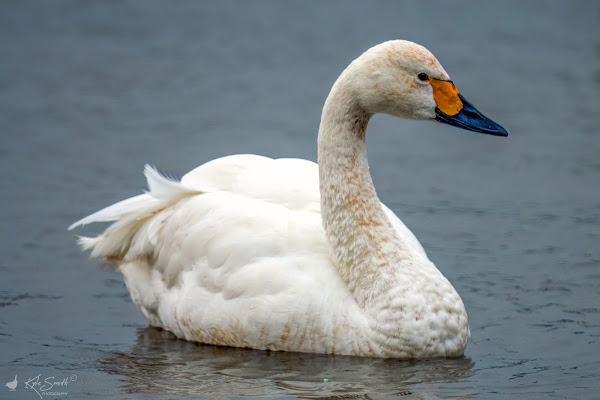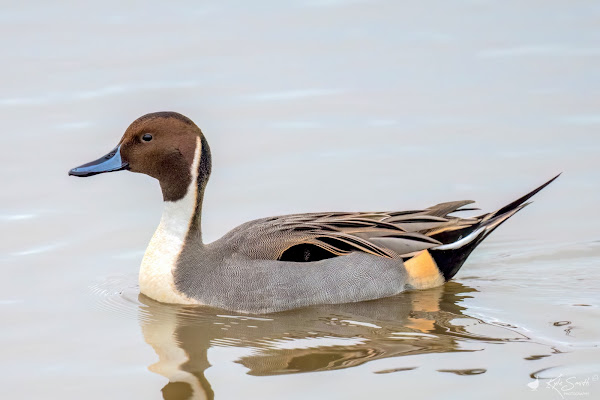Saturday’s forecast was for heavy rain through to lunchtime, and then for the wind to increase to 40-45mph for the rest of the day. The weather was to clear from the southwest and so we decided that a site with hides and towards the southwest would be best. Kev @kev07713 had been keen to return for seconds to the Devon coast where he'd had Hume's and yellow-browed warblers plus cirl buntings – and he knew I still hadn't added a yellow-browed on my year list. We opted though for WWT Slimbridge as the weather wouldn't be conducive to catching up with the warblers (neither the rain or the wind) - never a bad day at Slimbridge.
On the way the roads were edged with large puddles, the rain already in full swing and heavy - it became lighter as we progressed and slowed to a drizzle by the time we stopped for breakfast. As we arrived it had almost stopped altogether - we decided to make for the path with the longest path to take advantage of what might be a brief interlude.
At this time of year at Slimbridge it is all about returning swans and so we made for Rushy and it was great to see the Bewick's swans back. Bewick’s swan is a winter visitor to the UK and is the smaller of our two winter swans, with a relatively small bill. The Bewick’s swans which winter in the UK breed largely in the Russian tundra and each autumn, adults arrive with their grey young from the year and even in large winter flocks they will maintain family bonds throughout the winter.
We arrived at Rushy Hide and counted 54 Bewick's - no doubt there would be others across the reserve - and at least 9 of them juveniles. There were lots of ducks and geese on view.
It is a good time of year for numbers of many of the duck species, most notably wigeon. Another population that seems to swell at this time of year are pintails - long-necked and small-headed ducks, the males easily distinguished from other species. The pintail is a 'quarry' species, meaning that it can be legally shot in winter, but unlike in parts of Europe it does not appear that shooting is affecting their population status in the UK; the UK has a small breeding population but a significant winter population. Pintails, and pochards were represented in significant numbers and looked dashing on a grey, dank and increasingly blustery day.
Having scanned through all the birds and noted grey wagtail and a handful of common snipe, we moved along and from the Robbie Garnett Hide we could see two whooper swans. The whooper swan is one of the larger swan species and like the smaller Bewick’s swans, adults have a characteristic black-and-yellow bill, but in the whoopers the yellow markings extend in a wedge-like shape from the base to (or beyond) the nostrils. They swam to the left and eventually stopped to preen. Along the front edge of the water, we could see around seven snipe - but no jacks.
We soon reached the Estuary Hide and looked out hoping to pick up some cranes - it would be a while before we found two very distant individuals. We looked back across the Tack Piece and saw a couple of dozen curlews and large groups of mixed redshank and ruff. There were also large numbers of golden plover, lapwing and dunlin.
Looking out in front of the hide we picked out a marsh harrier on the ground - it seemed to be standing on something and then appeared to start feeding on it. While lapwings often get up as a marsh harrier quarters the area, you don't often see lapwing in their talons ... there were flocks of lapwing around and a few bombed our harrier, but it only moved away by around ten feet but taking it's quarry with it. Perhaps a sparrowhawk/peregrine catch and picked up, or a sick lapwing?
With some of the windows open we could hear geese coming in, a large flock - white-fronted geese that didn't stop, flying straight through. In the distance were bar-headed, Ross's and snow geese plus a brief appearance of the lesser- white-fronted goose. To the side were two Brent geese amongst a flock of Canada geese.
I looked out the back of the hide and spotted a male sparrowhawk resting in a tree. I watched as it was blown about, feathers dancing in the wind and branches swaying. Kev and I looked through the window and shared the bird with another birder in the hide. Once everyone had seen the bird, I eased the window open and thankfully didn't spook the bird, allowing some better views and photos. No doubt one of the reasons the golden plover, dunlin and lapwing were frequently driven onto the wing.
As we left the hide we met up with Kev's sister Karen @hobbylovinglife and her partner Dean @worlebirder. Kev had been birding with Karen in recent days and so we chatted briefly before agreeing to meet up later.
We made our way on to the Kingfisher Hide and watched black-tailed godwits and flocks of geese containing barnacle, Canada, greylag, and white-fronted geese. We heard a call from a kingfisher but never got eyes on it. The wind was really getting up now and was howling over and through the roof. Time to head back, stopping on South Lake on the way.
We bumped into Karen and Dean again, looking for jack snipe and finches, without much success. After another catchup we were off again.
We'd been keeping our eyes open for redpoll and siskin around the site and had only heard but not seen, siskins. Now we saw a male in the tree canopy actively feeding. One became two and then ten, in a mixed flock with goldfinches. In the winter, siskin often gather in groups with lesser redpolls and feed on seeds in birch and alder. Try as we might we couldn't make one into a redpoll.
Siskins are a resident breeder from southern England to northern Scotland, but generally most numerous in Scotland and Wales - many are residents but in winter many more birds arrive to the UK from Europe.
Happy with our day, we made our way back to the car, dropping in on the way home to try and catch up with some short-eared owls but were unsuccessful largely as a result of the weather, the wind and temperature conspiring against us.

















No comments:
Post a Comment